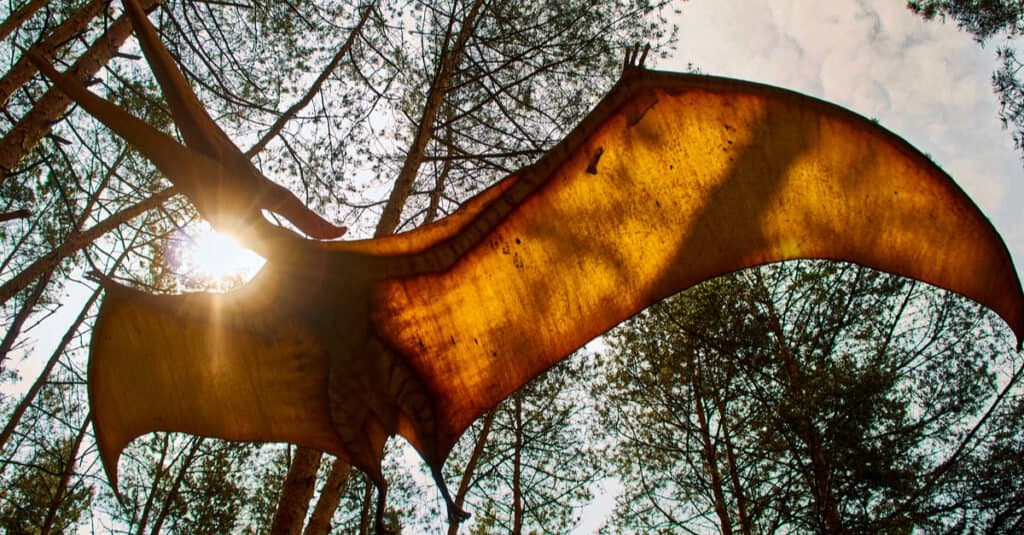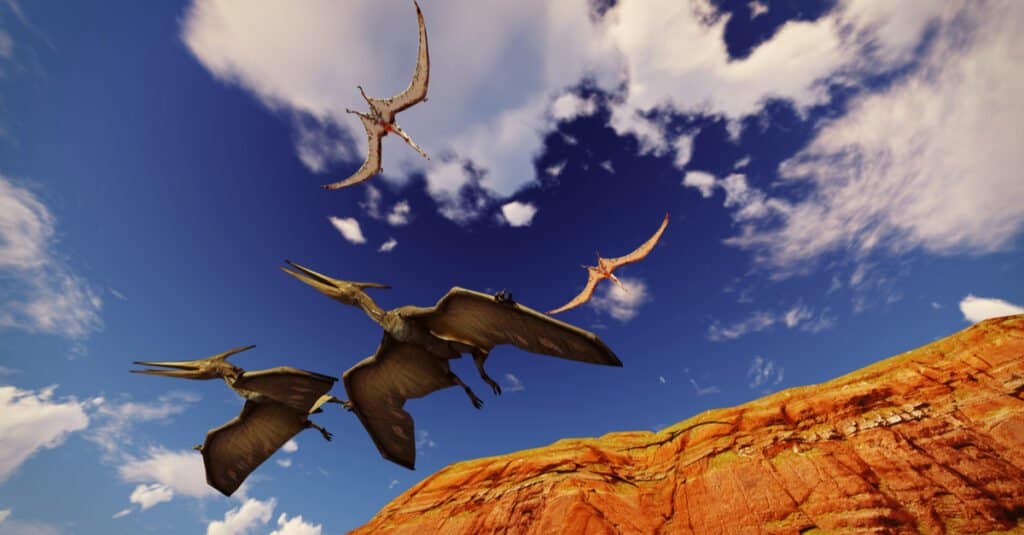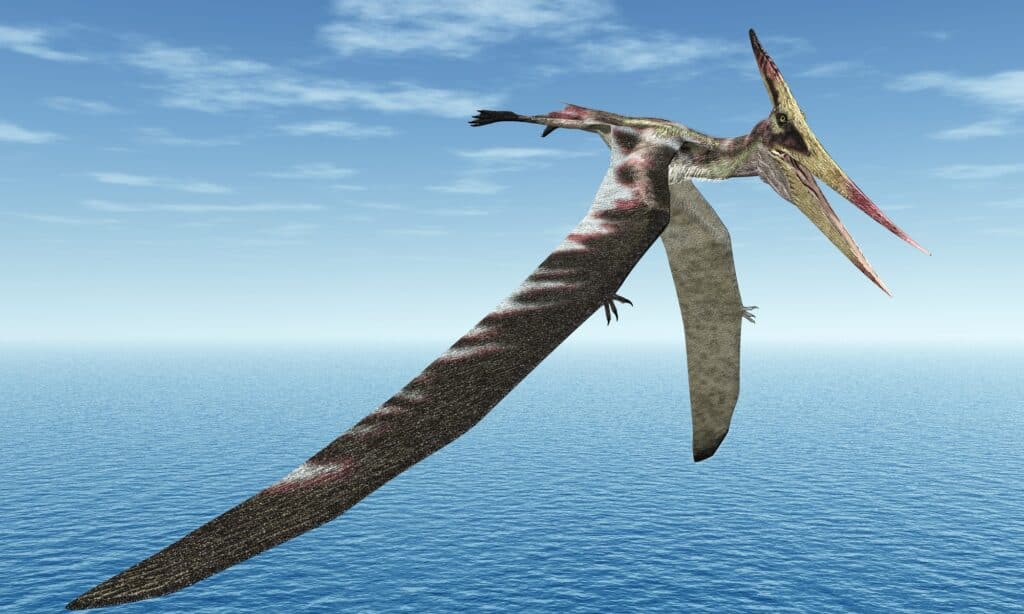There is still so much we don’t know about ancient creatures, whether they are reptiles or dinosaurs, including the differences between a Pterodactyl vs Pteranodon. These two creatures may belong to the same genus of flying reptiles, but there are many differences between them. If you have always wanted to learn more about Pterodactyls and Pteranodons, you’re in the right place.
In this article, we will discuss these creatures in detail, including the ways in which they differ from one another. We will address the eras and periods in which they lived, as well as their preferred diet and appearances. Let’s get started now.
Comparing Pterodactyl vs Pteranodon

| Pterodactyl | Pteranodon | |
|---|---|---|
| Genus | Pterodactylus (Pterodactylus antiquus) | Pteranodon |
| Period/Era Alive | late Jurassic period through the late Cretaceous period | Late Cretaceous Period |
| Appearance | Smaller than Pteranodon and winged, but capable of walking on land. Soft head and many teeth | Large and winged with no teeth and no tail; long pointed beak and large skull crests made of bone |
| Diet | Small mammals and dinosaurs | Fish, insects, mollusks, carcasses |
| Has Teeth? | Yes | No |
The Main Differences Between Pterodactyl vs Pteranodon

The Pterodactyl existed in the Jurassic period, while the Pteranodon existed in the Cretaceous period.
©Ekaterina Glazkova/Shutterstock.com
There are many differences between a Pterodactyl vs Pteranodon. While they are both creatures from the Pterosaur genus, these two species existed during different eras. The Pterodactyl existed in the Jurassic period, while the Pteranodon existed in the Cretaceous period. Pteranodons are also much larger than Pterodactyls, and they do not have teeth compared to Pterodactyl teeth.
There are many more differences to discuss. Let’s get started and look at these differences in more detail.
Pterodactyl vs Pteranodon: Era and Period Alive

Pterodactyls differ from Pteranodons in that their heads were soft, while Pteranodons have hard heads with large crests atop them.
©Catmando/Shutterstock.com
One of the key differences between Pterodactyl vs Pteranodon is the era they lived in and what period they existed in. While both creatures were alive throughout the Mesozoic era, they lived during different periods of this era. Based on our knowledge, it is unlikely that these two creatures existed during the same era. Let’s discuss this in more detail now.
Pterodactyls lived primarily during the latter end of the Jurassic period while Pteranodons lived toward the end of the Cretaceous period. While this may not mean very much at first glance, there are millions of years separating these two time periods, so it is unlikely that these two reptiles ever met!
Speaking of these two creatures never meeting, the location in which Pterodactyl and Pteranodon fossils have been found is also interesting. Pteranodon remains were first found in North America, specifically the Midwest, while Pterodactyl remains were first found in Germany. This gives us great insights into where these creatures may have lived so long ago.
Pterodactyl vs Pteranodon: Appearance

While Pterodactyls remained a similar size regardless of their gender, Pteranodon males were much larger than females.
©Dariush M/Shutterstock.com
Another difference between Pterodactyls vs Pteranodons is their appearance. While both creatures are members of the same genus, there are key physical differences between them, likely caused by centuries of evolution and adaptation. The primary physical difference between these two creatures is the presence of teeth, but we’ll talk more about that later.
Pterodactyls are much smaller than Pteranodons. They are both winged creatures, but Pterodactyls often walked on land with the help of their hands. Pterodactyls also differ from Pteranodons in that their heads were soft, while Pteranodons have hard heads with large crests atop them.
There are also size differences between the genders of each creature. While Pterodactyls remained a similar size regardless of their gender, Pteranodon males were much larger than females. Female Pteranodons had much wider hips compared to males, likely due to the fact that they laid eggs.
Pterodactyl vs Pteranodon: Presence of Teeth
While the answer may surprise you, a key difference between a Pterodactyl vs Pteranodon is whether or not they have teeth. These two creatures are separated by this fact. Pterodactyls have teeth, while Pteranodons don’t- their beak is more curved and resembles a beak closer to a modern-day pelican.
Pterodactyls have narrow beaks and skulls with nearly 90 teeth, which is a key difference from Pteranodons. While these two flying reptiles may seem similar and belong to the same genus, they are separated by the presence of teeth alone.

Given the fact that Pteranodons do not have teeth, they likely were incapable of hunting and consuming live dinosaurs like Pterodactyls did.
©YuRi Photolife/Shutterstock.com
Pterodactyl vs Pteranodon: Diet
A final difference between a Pterodactyl vs Pteranodon lies in their diet. Given the fact that Pterodactyls have teeth and Pteranodons don’t, this has clear and present effects on their diet. Let’s talk more about these differences now so that you can fully understand these two unique creatures.
Pterodactyls and pteranodons are both carnivorous creatures but with a few key differences. For example, Pterodactyls ate small dinosaurs and other animals while they were alive, while Pteranodons preferred to eat fish as well as the carcasses of other dinosaurs. Given the fact that Pteranodons do not have teeth, they likely were incapable of hunting and consuming live dinosaurs like Pterodactyls did.
What is the Difference Between a Pteranodon and a Dinosaur?

Pteranodon was a flying reptile that belonged to the order Pterosauria.
©iStock.com/MR1805
Although the Pteranodon is one of the more well-known Pterosaurs and is quite often featured in dinosaur media, they actually belong to the group, or order, Pterosauria while dinosaurs belong to the group Dinorsauria. Like many other ancient animals, such as the wooly mammoth, these are often all grouped together as dinosaurs even though they are all completely different species that belong to different orders.
These animals were not only not dinosaurs, but they were also not birds. Pteranodon, much like the Pterodactyl, belongs to a class of flying reptiles. What were they? Flying reptiles.
These flying reptiles have traits that evolved much earlier in evolutionary history than those of the dinosaurs, although they are close cousins, having separated close to 250 million years ago. They are differentiated by their bones – flying reptiles have no holes in their hip sockets as well as no long crests on their upper arm bones.
The photo featured at the top of this post is © Dariush M/Shutterstock.com
Thank you for reading! Have some feedback for us? Contact the AZ Animals editorial team.






